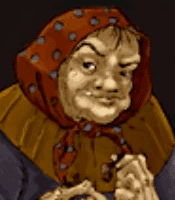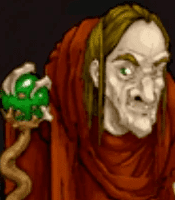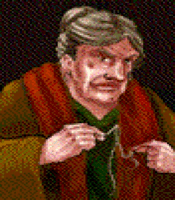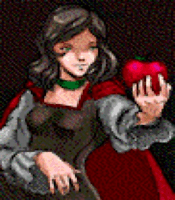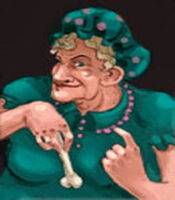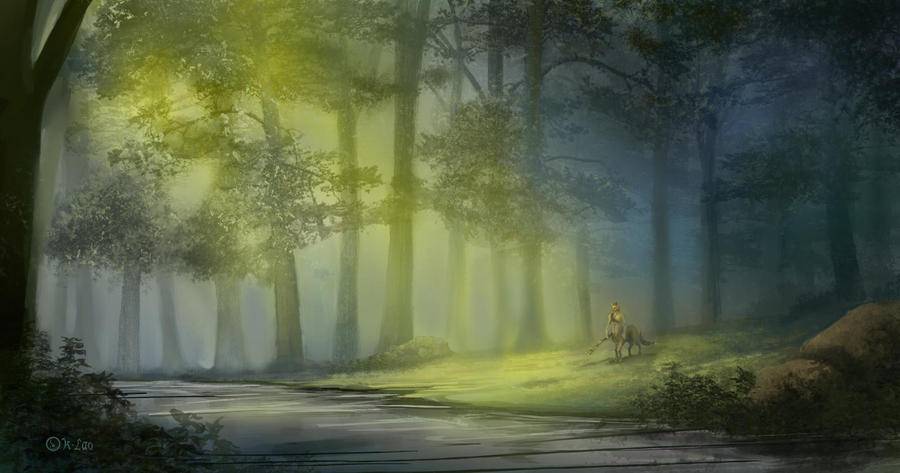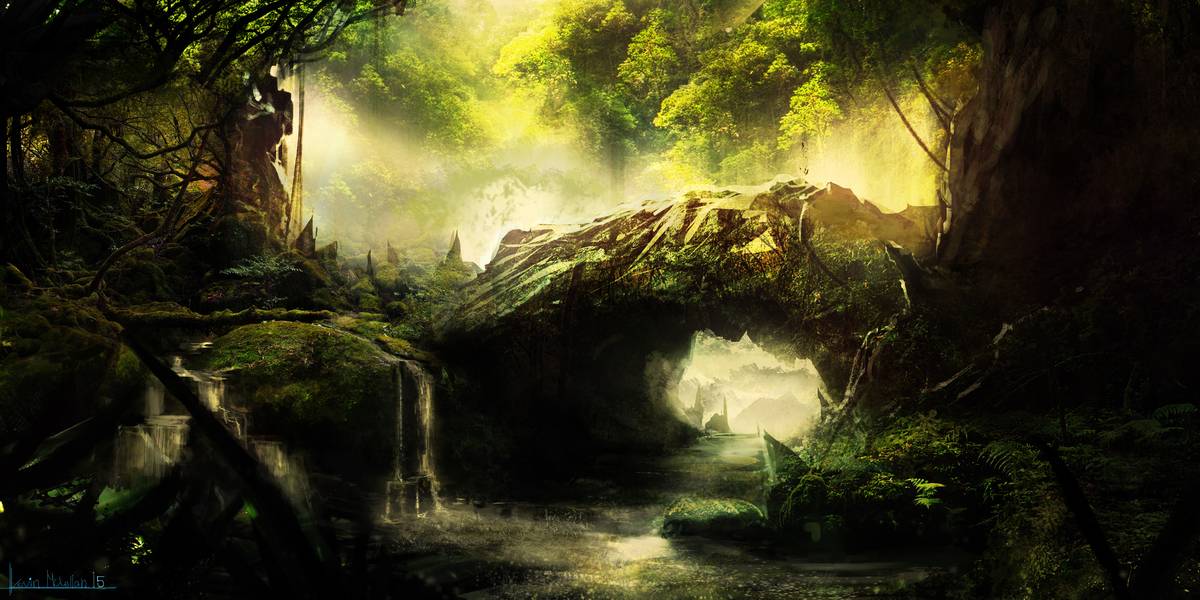Beings of the Wizarding World
Werewolves
OFFICIAL TERM
Lycanthrophe, derived from the Greek word lukanthrophia (lukos: wolf, anthropos: human)
CATEGORY
Lycanthropy is to be seen as a disease that can affect a human host under given circumstances; these include both non-magical humans, as well as wizards/witches and squibs. It is to be seen as a disease, even though some might refer to it as a curse. However a curse falls under the classification of a dark Charm and as Lycanthropy is inflicted by the bite of a mindless beast, the official classification would be disease. If someone should be affected by this disease they are commonly referred to as werewolf, a beast that during full moon nights the Ministry of Magic sees as a level XXXXX creature. However on each other day and night a werewolf is to be seen as the same as any other human.
INFECTION
Every human being can become a werewolf no matter their age or condition, but once a werewolf there is no going back. A person may be infected through the bite of a werewolf while they are in their wolfish form. That said it has to be on a full moon night. When the saliva of the werewolf mingles with the blood of their victim they are to be categorized as a werewolf, or lycanthrope. Most victims of such a bite die due to blood loss, but powdered silver and dittany that is applied on a wound inflicted by a werewolf will be able to seal the wound; however this will not stop the infection with Lycanthropy.
BASIC INFORMATION
As soon as a human is infected by this disease they will go through monthly painful changes on each full moon night. The lycanthrope will have no say in this change and it cannot be avoided under any circumstances. Upon transformation the lycanthrope will no longer be able to remember their human nature and will not be able to access the memories and feelings of their human self. They are known to become ruthless in their wolfish form, as they are no longer able to differ between friend and enemy and would attack and even kill everyone if given the chance. They might attack animals but are known to be less aggressive towards them, which allows wizards in their animagus form to keep a werewolf company during full moon nights. A way for a werewolf to regain their human mind during the monthly transformation is by drinking the Wolfsbane Potion.
However once they turn back into a human they will, regardless whether they drunk the wolfsbane potion or not, be able to recall the memories of everything they have done during the full moon night.
A bitten human will always have a scar as an eternal reminder of the event. Once a werewolf, even if in their human form, they are known to have enhanced senses. This also leads to an ability to have better sight and smell.
Werewolves have a tendency to hurt themselves during transformation, which happens by accident or when the werewolf is locked up and unable to run and hunt. Those are usually deep wounds that miss treatment for several hours of the night and would cause a heavy blood loss, which is why it is assumed that werewolves have some enhanced regeneration abilities in their wolf form. However, the wounds caused by a werewolf will have to heal naturally or with the aid of magic. A bite or scratch wound inflicted by a werewolf, whether in human or animal form, will leave scars.
If a werewolf in their human form bites or scratches another person to the point it draws blood, whatever the reason may be, the victim will not turn into a lycanthrope. However they are known to develop lupine tendencies such as a love for rare meat and other small changes. Any bite or scratch from a werewolf, whether they are in their wolf or human form, will leave permanent scars that no spell or potion can heal, however a mixture of powdered silver and dittany once again will be able to seal said wounds.
With no human around or animals to keep him company werewolves are known to be so restless that they may accidentally inflict wounds on themselves during their transformation. They are known to be weaker after their transformation back into a human as the pain from the transformation will weaken them for multiple days.
It is unknown whether a werewolf can be born, as there has been no known case so far.
APPEARANCE
Usually except for full moon nights the werewolf will not look much different from how they did before they were infected. They stay in their human form and will age normally. However in some cases their eyes change in color, often to a more shining amber or yellow color when turning into a wolf. But only on nights where the full moon stands in the sky will they change their appearance and turn into their full wolfish form. When a werewolf gets older they might grow more body hair, though this does not affect all of their kind.
Against many believes they will not transform into a half man, half wolf creature. They will mostly look like common wolves, even though they will be bigger than those animals. They can have any fur color that also exists naturally, but often the color of the fur resembles the one of their hair of their human form. A werewolf can be distinguished from a common wolf by traits such as a shorter snout and more human-like eyes, as well as by their tufted tail and their hunt on humans.
While still in their human form a werewolf is known to gain a pallor as the moon approaches and leaves, which will leave each werewolf sickly pale during the time closest to the full moon.
CURE
There is no known cure for Lycanthropy and there most likely will never be a cure. However there is a potion known as Wolfsbane Potion that will help the werewolf to regain their human senses and also eases the pain a person feels during the transformation. This potion was invented by Damocles Belby.
The person drinking the potion must drink a goblet-full of the potion once a day for a week going up to the full moon for the effect to be at their fullest potential. Even one missing dose can minimize the effect of the potion or render it as ineffective the following full moon night.
REPUTATION
In usual circumstances many in the wizarding world react with fear or disgust to werewolves, as many still believe that the werewolf even in human form can pose a danger to the human society. A werewolf often has to face discrimination in the wizarding world, which also makes it more difficult for them to get a job, as usually people do not want such 'beasts' in their establishments. This leads to many werewolves keeping their disease a secret and staying unregistered, which only serves to further the distrust and persecution.
In the year 1993, a prejudiced witch called Dolores Umbridge even passed an anti-werewolf legislation. This law made it even more difficult for werewolves to find employment, forcing them into poverty and to take jobs that were below their abilities. Other werewolves were driven to join the side of Voldemort as they were tricked to believe that they would have a better life under his rule where they would not be discriminated.
After Voldemort's defeat in the year 1998 the anti-werewolf legislation was repealed by the next Minister of Magic, Kingsley Shacklebolt. After his death the werewolf Remus Lupin was rewarded with the Order of Merlin reserved for people who achieved great things for the wizarding world. Lupin was known as the first werewolf to ever receive this award, which also helped to discourage some of the prejudiced beliefs against werewolves. However the wizarding society's opinion on werewolves and whether they should be shunned from society is still argued by many wizards.
*Lore by Thurston Barclay.
Last edited by AngelFyre McCubbin on 31 Jan 2024, 06:20, edited 2 times in total.
Reason: Edited spelling error in last paragraph; believes to beliefs.
This is the "Game Master" account. Please do not owl this account, unless specified. This account is not moderated actively and therefore, you may not receive a response.
Contact a Head of House or the Headmaster if you need anything.
Beings of the Wizarding World
Muggles
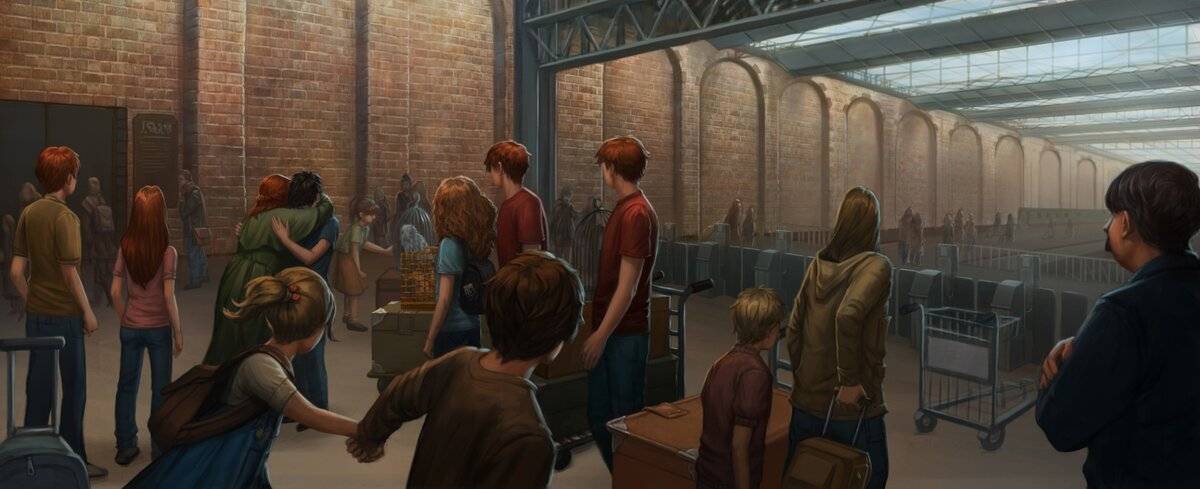
What are Muggles?Wizard's Perspective:
Humans, or muggles, are races that do not have any sort of magic. They are most commonly unaware of the magical world and if they do figure out the other dimension, it is considered the "supernatural" for them. While some believe in the supernatural, most find it to be non-existent or fake among other muggles.Scientific Perspective:
To the muggle scientists, humans can be made out of the following elements of the periodic table: oxygen, carbon, nitrogen, calcium and phosphorus. There is a very small amount of percentage that a human is made out of potassium, sulfur, sodium, chlorine and magnesium. These elements have a series of atoms that when combined together, can create a human.
It is said that humans are primarily made out of water than anything else. Even to this day, muggles are often figuring themselves out and as of 2018, they believe that they are also made out of stardust.Religious Perspective:
Humans are created by one powerful, invisible being that most humans refer to as “God”. There is a mythological story that explains how the world was made and on the sixth day, God created the first ever human man and woman: Adam and Eve.
Humans are explained in multiple different languages including Latin, Hebrew, Greek and Arabic that they are made out of the dust, clay, or the dirt of the land as it was how God made the first two humans.Philosophical and Psychological Perspective:
Unlike creatures and other animals, humans are rounded in their spiritual, emotional and physical perspectives. They are beings that can believe in the nothing and yet rely on their sight. Humans question their state of being and will always look for more than they can chew.
Muggles can think positively or negatively depending on their personality and mood of that moment. They can make poor decisions and successful decisions and can deal with the consequences and rewards that come with them.
Muggle AppearanceBody:
The appearance of muggles is very similar to that of witches and wizards. Muggles have two segments to their body: head and abdomen. Connected to the abdomen are two arms out the sides and two legs that are out the bottom. Most muggles have hair, two eyes, nose and mouth with two ears.
While their form is very much like magical folk, muggles can also go through birth defects that change their overall image at birth. Examples may be that their arm or leg are missing, or if they are twins, they are conjoined with their sibling. Muggles have many forms of science that help acknowledge and move forward with these symptoms.Genetic Makeup:
Muggles are born with whatever coloring they have. The way they look comes from genetic makeup, or DNA, that come from their parents and early generations in their family. Their genetics determines a muggle's heritage, ethnicity and race. Coloring, a type of makeup, can affect their skin, eyes and hair. Muggles are born with either gray, blue, green, brown, black or hazel eyes; blonde, yellow or red hair; and a range between dark to light skin.
Genetic makeup of muggles does not only affect their coloring, but also their body structure. Every aspect of a muggle is determined upon their genetics from family whether it be the shape of their nose or jaw line, or even their height. Every muggle is made differently, even those who are twins.
Muggle-Wizard RelationsMuggles and Wizards have been living parallel for hundreds of years. It is regulation to separate the wizarding world with the muggle world due to unfortunate historical events such as the infamous Witch Hunts. There are those who share their magical abilities with muggles and intermarry with one another, however, it is not at all that common.
To ensure the safety among magic folk, the Ministry of Magic has a position of Muggle Relations that is based in the Muggle Liaison Office within the ministry.
*Lore by Maya Galim.
This is the "Game Master" account. Please do not owl this account, unless specified. This account is not moderated actively and therefore, you may not receive a response.
Contact a Head of House or the Headmaster if you need anything.
Beings of the Wizarding World
Hags
|
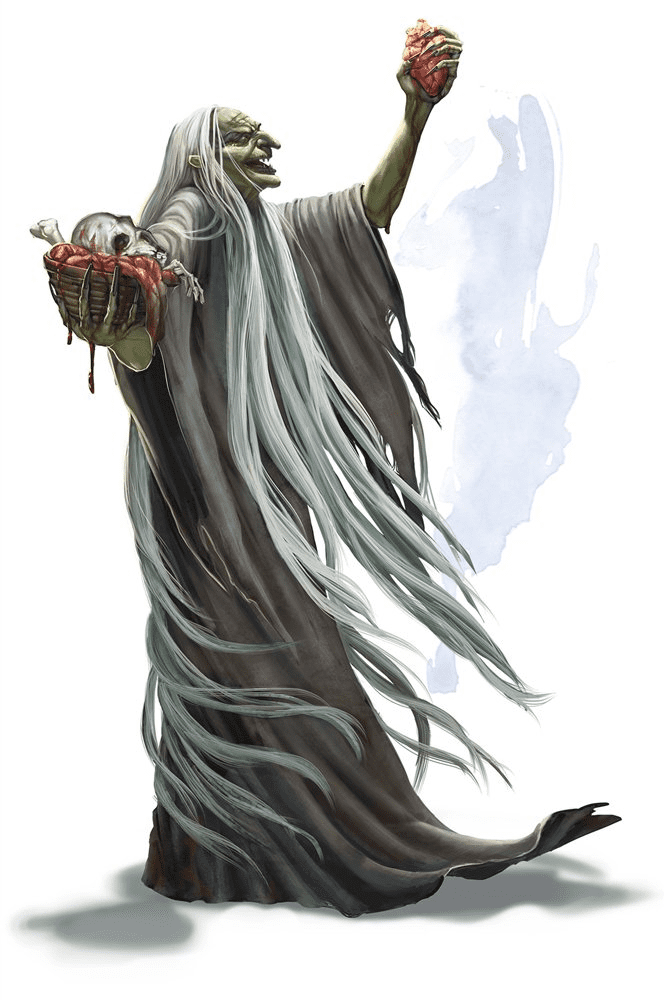 |
|
|
|
|
|
|
Physical Attributes:
 Ugly, often old.
Ugly, often old. Many warts.
Many warts. Festering wounds are common.
Festering wounds are common. Many times a terrible, "unhealthy" scent, as if something might be rotting.
Many times a terrible, "unhealthy" scent, as if something might be rotting.  Has five fingers but only four toes.
Has five fingers but only four toes. Has rudimentary magic, similar to a troll.
Has rudimentary magic, similar to a troll. Potion masters
Potion masters Use a basic, dark magic
Use a basic, dark magicAccording to Solomon's book on Hags known as Mothers of Evil:
Hags are cantankerous crones who represent the cruelest corruption of human and humane desires and goals, they delight in seeing the pure and good brought low. Monsters, their forms twisted by the evil that is in their heart. A blasphemous existence, hags are often found alone but when they ally with other hags to form magical covens, their power and avarice is dangerously magnified. Often reflections of carnal sin, some collect and remember clandestine knowledge that is better forsaken. The most desperate among people come to them looking for power or advice that they gladly give, but every deal with a hag comes with a terrible price.
Often hags perceive beauty as atrocious and they revel in having a hideous appearance, their flesh a reflection of the terrible nature housed within. There is on occasion the exception, some hags are capable of incredible beauty but this is only to feed their personal vanity. In some cases they take on the appearance of a lovely woman so that they can gain power or influence, but this beauty is often short-lived as they find such to be humiliating. The persons they looked lovely for often suffer the most as they seek vengeance upon them.
Hags are virtually immortal, with a life span greater than that of wizards, it is not recorded how long a hag actually lives but it is believed to be measured in the hundreds of years. The oldest, wisest, and most powerful hags are called “grandmothers” by other hags and hold such a title in high esteem. Such hags, if encountered would be as powerful as a legendary wizard. Younger hags are referred to as "mothers" and are incredibly dangerous and powerful and should be avoided at all cost. The only recorded "mother" hag was Mother Hubbard. The most powerful hag I have ever encountered was an Auntie, the most vile and terrible creature I had ever seen. Blindingly hideous with the most foul stench I have ever experienced, she tormented a small town in Japan in the early 2000s. One-hundred and twenty children's deaths have been attributed to her. She was an unusual hag, not consuming the children but rather she fed the bits of children in a soup she sold in the market. She was killed, but it took the combined effort of six powerful wizards, four of which died during their final skirmish. Younger hags, called "sisters" are still powerful threats to wizard-kind and muggles if let loose and are more common.
Hags are manipulative wretches, the use of violence is often not used directly by a hag. They often prefer corrupting others, making bargains or giving them power that they would squander in a destructive manner. Hags often prefer to settle near muggle cities, specifically near where children play, however their presence in such places is often brought to a stop rather quickly. The ability to identify the location where magic has been used has hindered the ability of hags to settle near muggle cities. Because of this, hags have imposed their presence in magical settlements which are few and far in-between.
Their ability to tantalize and torment others has earned them minions, often the stupid, the disenfranchised and the angry. Folk with nowhere else to turn are some of a hag’s best customers. Some hags are shameless and offer their 'services' to any who ask, with the caveat that they know exactly who and what they are. A woman with a philandering husband might come to a hag to make the other woman less desirable, to make their husband love only them, or to perhaps even eliminate the competition. A student may ask a hag for something to make them smarter, to make the classes easier, or to make a Professor regret giving them a bad grade. A parent with a gravely ill child might seek something to make the child well again. Not only would these people approach the hag for help, despite knowing that she is evil and dangerous, but the hag would seek something in return and the assistance that she would give is almost always morally questionable.
Hags are not demons or devils, regardless of the rude association. The soul is not a commodity to a hag, in fact a soul is irrelevant. Hags do not believe in a heaven or a hell, the ghost stay after the body has broken. They feel that is sufficient evidence that a soul is merely a psychological construct. A hag barters with people purely because they enjoy making people miserable.
Hags sometimes go out looking for people to make a deal with. Due to a hag's reputation, many are rightfully hesitant to seek out a hag to make a deal or ask for help. Even if they are indifferent to the risk, there is a social stigma with making deals with such vile creatures and rightfully so. Keeping this secret is just another factor in a hag's favor. Often a hag's terms seem completely reasonable and some even have a tempting loophole or two that someone foolishly thinks that they can exploit but they are never an oversight. Hags are masters of making deals. Yet other people will come, believing that they can outsmart the hag, or that their need is too simple and can’t be perverted. They are wrong. They are always wrong.
A hag is never generous. A hag that freely offers her help, gives a 'fair' deal, or only asks for something simple as payment, the hag likely has a hidden agenda. In the end their agenda is always the same, she is looking to bring forth disaster for another, grow in power, or sate their gluttonous hunger. The hag’s reasons might not be immediately apparent, it may take years or even generations to realize the girth of her plan if it is ever understood. There is always a downside. There is always a secret motivation.
When cornered, a hag will make promises that they will not keep. They may offer treasures, but they are always cursed or will backfire. Never threaten or trust a hag. Hags are weak regarding information, their curiosity about powerful people, wizards or creatures may entice a hag to temporarily cooperate, cause them to give an iota or respect or offer something almost akin to a fair deal if the information proves to be accurate. Hags are far from foolish however, so you may be hard pressed to have information that a hag does not already have. Another weakness to a hag is their curiosity regarding unusual, powerful items. If the hag has nothing like an item offered, finds it to be a powerful tool against her rivals, or if it will prevent someone else from having an item of actual importance, she might be more willing to make a fair deal.
Hags never violently confront opponents unless they are cornered, they are overwhelmingly more powerful than their opponents (such as children) or have an unfair advantage (such as sleeping or severe illness or injury). If a hag attacks directly with her claws and her magic, something has gone very wrong with her plans or she has something up her sleeve that requires a fight. It is smarter to flee than to engage a hag directly if she started it.
Hag Lairs
Often located near magical creatures or humans, specifically children. The area around their lair is often corrupted by their presence as environment is becomes as twisted as the hags that inhabit it. The home or hovel that the hags live in is often a reflection of the sin that a hag reflects the most. For instance a gluttonous hag might live in a gingerbread house. A greedy hag might have a home that is overloaded with knick-knacks and treasures, many of them on display.
The terrain becomes unsettled for one to two miles around a hag's home. A forest can uproot and attack travelers. Clear paths might be filled with sharp stones that can pierce through the soles of their shoes. Small animals might become aggressive. Spiders and other insects may be found in abundance.
A hag's home can house one hag or several. Often a coven never reaches large numbers, most reach three and no more.
This is the "Game Master" account. Please do not owl this account, unless specified. This account is not moderated actively and therefore, you may not receive a response.
Contact a Head of House or the Headmaster if you need anything.
Beings of the Wizarding World
Metamorphamagi
"I'm a Metamorphmagus. It means I can change my appearance at will. I was born one."
—Tonks regarding her Metamorphic abilitiesOverview
A metamorph, short for metamorphmagus, is known to be a witch or wizard capable of changing their physical appearance as they please. This happens without the assistance of any magic such as spells or potions which makes this a unique trait. This ability is shown in very few people of the magical population and never in a muggle. The word itself stems from the Greek "meta" which means 'change' and "morph" which translates into 'shape'; lastly "magus" which stems from Latin, means 'magic' or 'wizard' - metamorphmagi are shape changing wizards.
This talent is not something you choose to acquire, but it is a recessive gene that is known to commonly skip multiple generations. While a muggleborn may show this trait, it would never show in a squib or muggle as it requires the magic gene to be intact. Moreover, there would be at least some magical heritage on both sides of the family tree, even if unknown to the metamorph in question. There is little use in denying the metamorph gene as it manifests from a very young age. Usually the first hints appear when the metamorphmagus is a newborn and at the latest these traits show when the person is a toddler.
It is impossible to overlook the signs, because they are quite apparent. At first the gene shows as a form of exaggerated emotions, such as the color of skin or hair may shift to resemble the newborns mood. Only later in life will the metamorph learn some control over this talent, with some struggling to subdue these emotional outbursts even in adulthood. As the metamorph grows they will also learn to purposefully use this ability to change aspects about themselves. A lot of metamorphs find meditation or breathing exercises to be valuable helpers in maintaining control over their talent.Powers & Limitations
A metamorph is not to be confused with an animagus or someone under the disguise of a Polyjuice Potion. Animagi become what they are through years of practice and perfecting their skill, whereas a metamorph is born the way they are. A metamorph is unable to alter their form to that of an animal, except in the most superficial and miniscule ways, and only with cosmetic effect. While they are able to extend and shape what is originally part of their body, they may not grow new body parts or features that would help them in the way an organ helps an animal, and their physical abilities will always remain strictly human. As such, they could give themselves the slitted pupils of a cat, but they would not be reflective or help them see better. Whilst they could transform their bones to appear as if they have bumps or horns, they cannot create new body parts or extend these bumps to any great degree. The same applies to body hair, they can only add or remove from what they have, and cannot completely or partially cover themselves in fur to add animalistic features to their appearance. For example, a metamorph can shape their ears into that of a cat’s, and grow patches of hair on top of them, but they would still be human ears cast into a different mould. Similarly, they can alter their nose to appear as that of a pig, or their lips into that of a duck's, but such changes are temporary and purely at a surface-level. Accordingly, metamorphs cannot create new body parts, such as a tail, nor can they recreate those body parts that have been lost.
A young metamorph will not be able to extend or shorten their body by more than a few centimetres, however as they grow older, they will be able to change their height up to one foot (30 centimetres). This way they can replicate the appearance of near to any person. That however does not mean that their copy would be flawless, they could still be caught if they fail to copy their mannerisms or speech. This means that a metamorph would need to properly study a person to make a believable copy of them.
While a metamorph may adjust their internal organs to match their portrayed height, they will not be able to make changes to, add, or remove any of these organs. This means that even if a male born metamorph might make themselves look like a female person, they would not be able to have those reproductive organs or vice versa. A metamorph will also not be able to keep their changed appearance up if they are unconscious or asleep, at that point they will always revert to their original body.Other Distinguishing Features
A metamorph does not necessarily differ from a normal human and therefore they do not count as non-human. Their ability to transform is seen as a talent rather than a race, caused by a gene. It is known that a metamorph might struggle throughout their whole life to fully control their ability to transform, especially if they are upset. As such, especially temperamental or emotional metamorphs would struggle to keep their talent a secret even into maturity.
As metamorphmagi age, they become more skilled in utilizing their ability, allowing them to master full copies or whole personas and major differences in height or size. They also develop a knack of seeing the subtleties of transformation magic and as such have it easier to spot an attempt of disguise. Generally metamorphs are known for their affinity to Transfiguration and are rumored to have it easier in such classes or mastery of such skills and spells.Metamorphs in Society
Upon discovery, the witch or wizard’s status as a metamorphmagus is reported to the Ministry of Magic, as metamorphs need to be registered due to the inherent risk of fraud and deception posed by those who can change their shape at will. That said, the Ministry of Magic allows the use of the ability during their auror training, giving the metamorph a direct advantage in examinations such as "Concealment and Disguise", the very same thing makes them valued spies and investigators.
The general population however is often wary of the metamorph as they are seen as unpredictable and difficult to trust, due to their ability to copy an appearance without much difficulty. Even changing small aspects about oneself is often considered as off-putting, as people are not used to it and often rely too much on their sight, which in the world of metamorphmagi is nothing but deceiving. This often causes a metamorph to hide their talent from the public as to not be judged unfairly.
*Lore by Alan Vanes
This is the "Game Master" account. Please do not owl this account, unless specified. This account is not moderated actively and therefore, you may not receive a response.
Contact a Head of House or the Headmaster if you need anything.
Beings of the Wizarding World
|
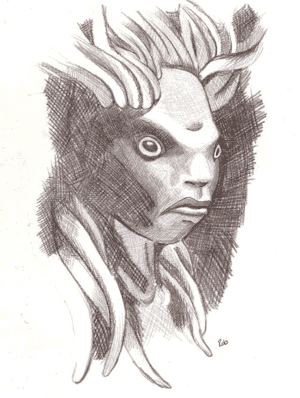 *credit to halfpennyro04 |
General Information
Merpeople, alternatively Merfolk, are sentient magical beasts that live entirely underwater. Of note, despite being of near-human (or human) intelligence, merpeople are not classified as Beings by the Ministry of Magic. Rather, they like centaurs, voluntarily are classified as Beasts, with their danger level rated at XXXX. Merpeople have rich and complex cultures, although due to their status as submarine creatures, they remain enigmatic to much of wizardkind. Whilst relations between wizards and merpeople are cordial, and friendships have been known to bloom, unlike other magical beings, they cannot interbreed with humans
Appearance
Merpeople resemble human-fish hybrids, yet are related to neither. Their most distinctive feature is their humanoid upper body, with a near-human torso, arms and head, partnered with a fish-like lower body, ending in a finned tail resembling that of the aquatic animal in question. This broad body plan proves the shared descriptor among the various subspecies and races of merfolk.
Merpeople, much like those sapient species that dwell above water, such as humans and goblins, vary in appearance dependent upon their region of origin. Those mermaids that inhabit warmer waters, such as the Sirens of the Mediterranean, more resemble humans than their more bestial cousins from cooler climes. As a result, the various types of merperson vary drastically in terms of aesthetics and overall appearance, from the sallow-skinned and black-eyed inhabitants of the freshwater lakes of Northern Europe, to the utterly human merfolk who beach themselves upon the various islets of the Mediterranean and Caribbean.
The most famous of the merpeople are the aforementioned Sirens, native to Greece, Cyprus and much of western Turkey and the Levant. These beings resemble humans of exceptional beauty, albeit these good looks are often otherworldly in quality. Often of olive skin, with delicate features and hair in colours of vibrant auburn and gold, Sirens entered into muggle myths through the tales of the sailors of ancient Greece. In addition to their appearances, they are blessed with even more lovely voices. The singing of sirens is so gorgeous that it is hypnotic, and in times of yore, they would lure unwary sailors into the water.
The Aycayia of the Carribean are similar in nature and in appearance. However, whereas Sirens are delicate and feminine in the beauty, the Aycayia are far more overtly seductive and sensual in their appearance and in their demeanour. However, much like their warm water counterparts in Europe and the Near East, their upper bodies are near identical to that of humanity, with their fishlike tails serving as the most obvious sign of their non-human status. The Aycayia look much like the Carib people indigenous to the area from which they hail, with bronze skin and long black hair. Moreover, their tails are more colourful than those of their cousins from warmer climates of the higher and lower latitudes.
To contrast with their warm-water cousins, cold-climate mermaids appear more fishlike. Their hair is often akin to kelp in its look and texture, their eyes are large and near-black, their teeth sharp and needlelike, and their slimy skin tinged with inhuman colours.
The largest merperson colony in the United Kingdom is that of the Selkies of the Black Lake, also known as the Great Lake of Hogwarts. Selkies have grey skin, with a texture not dissimilar to that of a seal, and dark green hair resembling that of a sea anemone. As with most cold-water merfolk, they have sharp, fish-like teeth and dark, too-wide eyes. However, their songs remain utterly beautiful underneath the water, and they adorn themselves with jewellery made of polished river pebbles.
Unlike their Scottish cousins, the Merrows of Ireland are almost entirely fishlike. With scaled skin and a lower torso that merges into their tail, their humanoid features are limited to a head that appears as a hybrid of fish and man, and their humanoid chests and arms. Their colouration is muted, rarely being more vibrant than a particularly interesting shade of grey.
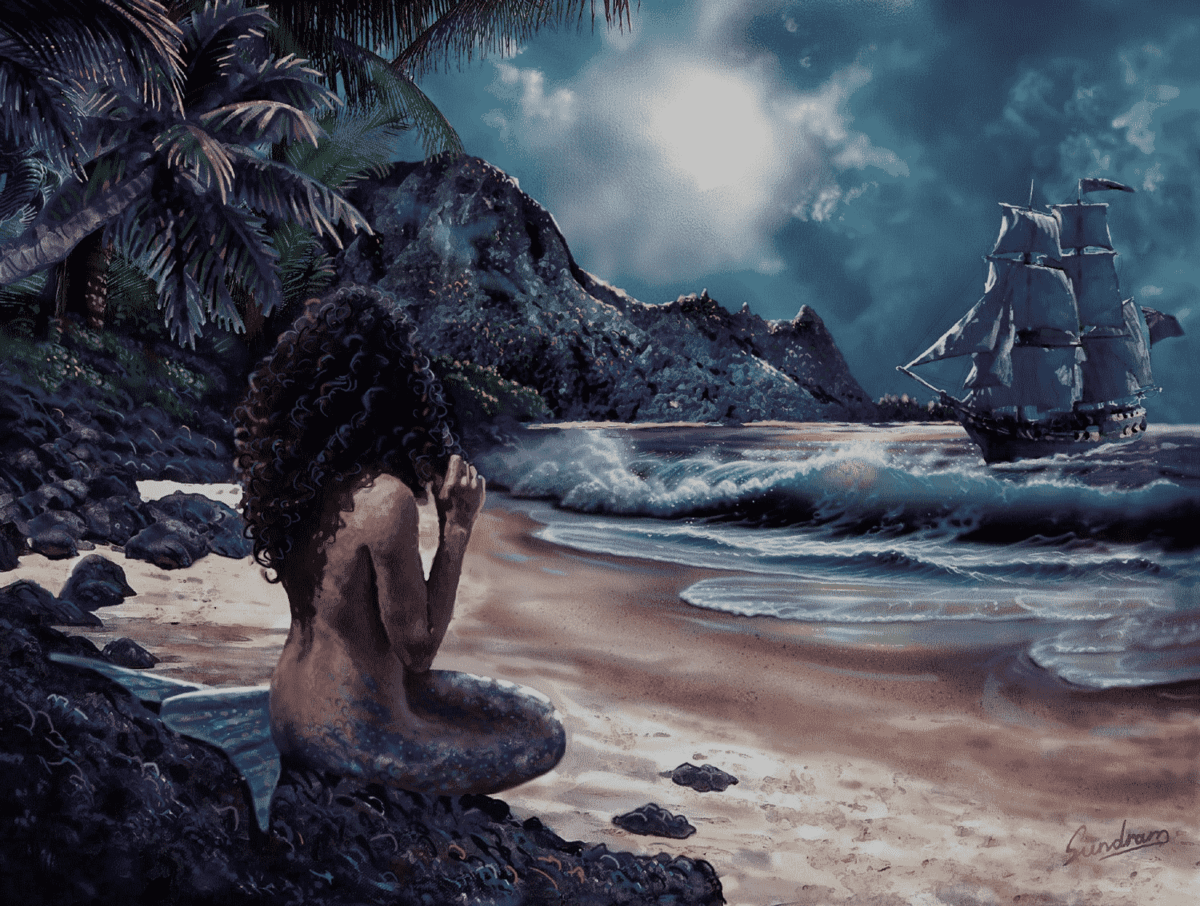
Habitat and Distribution
As one would expect, merfolk live under water, although their distribution varies greatly. Whilst they are confined to large bodies of water, the deep lakes of the British isles and New Zealand proving the smallest bodies to which they can comfortably colonise, their various subspecies can make themselves at home in both salt and fresh water. Typically, those merfolk that inhabit fresh-water bodies of water are the more bestial cold-water subspecies while salt-water mermaids appear more humanoid.
Despite the official use of the term 'habitat' merfolk settlements are more akin to cities and villages than they are to the environs of beasts. Using underwater metalcraft and coral-shaping, two techniques that remain mysteries to wizardkind, merfolk create elaborate constructions that serve as dwellings and meeting places. Most merfolk dwellings and structures are off-limits to visiting dignitaries from wizardkind, with ambassadors and magizoologists often contained to rather luxurious, if draconian, expatriate villages, not dissimilar to the Portuguese and Dutch trading posts of the Tokugawa shogunate. Interaction between outsiders and merfolk within their settlement is, without exception, limited.
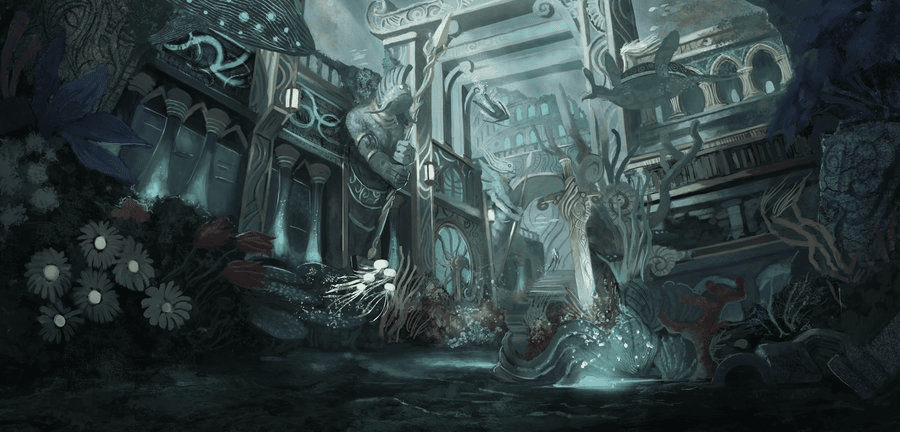
Culture
Merpeople are a sapient race, and have been objectively measured to be just as intelligent as humans. However, they have rejected the classification as a being as per International Wizarding Law. Such a rejection was formed partially out of a basis of political considerations, not wishing to be classified in the same vein as evil creatures such as hags, but also out of supposed necessity, with magical interactions with beings regulated and enforced by the Ministries of the world, the ever-elusive merfolk elected for Beast status in part due to a desire to maintain their blessed isolation beneath the waves. As such, due to said isolation, little concrete is known about the culture of merfolk by wizarding scholars, and even less by the public at large.
What is known about merfolk is that their culture is highly rigid and hierarchical, with each colony having a clan chieftess. Generally, merfolk societies tend to be matriarchal, with mermaids form the bulk of the ruling strata, with mermen often serving in physical and laborious roles. There are some exceptions to this rule, such as in the offshoot freshwater colonies of New Zealand and the North American Great Lakes, both of which trend toward egalitarianism, but for the most part, it is women of the tribe that attend to governance.
Men, on the other hand, are tasked with hunting, gathering and farming. Merfolk create large underwater agrarian complexes, created through a mix of mundane engineering and their unique magic. These farms are often owned and operated by extended family groupings, with mermen tending to the physical labour, whilst most of the trading and administrative tasks fall to mermaids. Many of the plants cultivated by merfolk are variations of wild kelp species and magical plants, albeit bred and developed to such an extent that they no longer resemble their native counterparts. Seedlings from these crops are highly sought after by wizard herbologists, but remain rare above-water due to the xenophobic nature of most merfolk societies.
Similarly, open-water mermen are tasked with hunting for fish and marine mammals and have complex means of establishing territorial borders. Where hunting grounds are infringed upon, colonies have been known to engage in skirmishes and, in rare occasions, outright warfare. Sirens, in particular, are famed for being the most warlike of any such subspecies. Given the nature of inland lakes and seas, most times only one colony will develop in such bodies of water, with splinter groups either being subsumed back into the collective or going in extinct. As such, there is little to no interaction between differing colonies of freshwater merfolk.
Otherwise, what has made its way to the wizarding world are the two great arts of the merfolk: music and metalwork. The music of merpeople is known for being both hauntingly beautiful and horrific to listen to. Above the water, the voices of merfolk are often shrill and difficult to hear, and have been known to cause insanity in sailors. However, underwater or in thick moisture (such as fog or rain), they are known to enchant and bewitch. The melodies are decidedly alien and all too sweet for human ears. However, it is known that music plays an integral role in merfolk courtship and ritual, to the what extent remains a subject of scholarly debate, but it is presumed that a talented musician can move up the social rungs with ease.
As to metalwork, merfolk are less famed than their goblin counterparts, but this is not due to a lack of skill. For the most part, mermaids are even more loathe to part with their crafts than that of goblins, who regularly engage in life loans with wizardkind. When a mermaid gifts a good, it is the property of the recipient forever, and it cannot be willed or wished to another, and must be left to rot once they have parted their mortal coil. The most famous of all mermetal crafts is the legendary sword granted to King Arthur, which is said to have been cast aside, as per merfolk law, upon his death. As such, it remains lost to this day.
*Lore by Magdalena Wickham-Deakin
The soul becomes dyed with the colour of its thoughts
Beings of the Wizarding World
→ CENTAURS ←
General InformationCentaurs are widely considered the magical world's closest relatives to the human being. From their human-like upper appearance to their intelligence that, in many cases, exceeds that of a human, centaurs are considered to be some of the most fantastic of all creatures for their striking resemblance to us. Like Merpeople, Centaurs are voluntarily classified as beasts rather than beings.
*Credit to K-Lao.Physical AppearanceCentaurs resemble two different creatures: human beings on the top, and horses on the bottom. In coloration they vary based upon location and genetics. Centaurs, despite common misconception, are not considered half-breeds and are their own species.
Much like both horses and humans, centaurs come in a variety of shapes, sizes, and colors. They may display any of the common horse coat colors or patterns.The human portion of the centaur is much the same. Centaurs may boast a number of skin tones, skin textures, hair colors, hair textures, and hair lengths. It truly depends upon genetics, just like we see in human beings.Coat Colors and Patterns
There are numerous colors and patterns that may manifest upon the coat of a centaur. Colors may be as follows:Centaur color and pattern conventions follow that of non-magical horses.BAY: Bay refers to a reddish-brown or brown coloration of the fur, with black point coloration on the tail and legs.
xxxxDARK BAY: The bay pattern in a darker shade, can appear almost black.
xxxxBLOOD BAY: The bay pattern in a red-toned brown.
CHESTNUT: Reddish-to-brown color coat with a tail of the same or lighter color. Absolute absence of true black hairs.
xxxxLIVER CHESTNUT: Darkest shades of this reddish pigmentation.
xxxxFLAXEN CHESTNUT: Refers to when the tail is a significantly lighter shade than the coat.
GRAY: A gray pigmentation of the coat, or a gradual de-pigmentation of otherwise saturated colors.
xxxxDAPPLE GRAY: A gray based coat with dappled lighter patterns across the body.
xxxxROSE GRAY: Refers to a gray coat with a warm, pink toned sheen.
DUN: A coat color dilution, with the legs and tail remaining undiluted.
xxxxRED DUN: Also known as claybank. A chestnut coat color affected by the dun coat dilution.
xxxxGRULLA: Also called a gray dun, blue dun, or mouse dun. Characterized by tan-gray or blue-gray hairs on the body affected by the dun dilution gene.
LEOPARD: Characterized by variable amounts of white in the coat, appearing often as spotting.
xxxxSNOWFLAKE: When a dark body is littered with white spots, appearing as snowflakes in a night sky.
xxxxVARNISH ROAN: Often seen in older centaurs, a progressive silvering that causes the light colored spotting to spread.
PINTO: A coat color that is characterized by large white patches and any other color.
xxxxPIEBALD: Black splotches on a white background.
xxxxSKEWBALD: White splotches on a background of any color except black.
BLACK: A pure black coat color.
BRINDLE: A striped coat pattern that can occur on any base color.
BUCKSKIN: A tan-ish, golden coat color. The tail and legs are solid black.
PERLINO: A bay base with a dilution in color, resulting in a pearly tan.
RABICANO: A pattern that is seen in many base colors, causing white hairs on the barrel, flank, and tail base.
WHITE: Pure white coloration on all aspects of the horse-half.
Centaurs cannot procreate with humans.Habitat & DietAs previously stated, centaurs can be found in a variety of places. Europe is their homeland, concentrated specifically in Greece, Great Britain, and Croatia. Centaurs prefer to live in relative isolation, free from Ministry and wizarding world intervention, meaning that deep forest dwellings make for the perfect homes. Forests allow them to construct their homes from the natural materials that lay there. Often, when witches or wizards pay the innards of forests a visit, deep within, they might find small societies and homes. Due to their tall statures, Centaur homes are tall and large to accommodate Centaur families and the space they require to survive.
Centaurs settle deep within forests, and it is rare that you will find a settlement near the edges of a forest. They choose areas with running water, plenty of overhead foliage, and an abundance of small creatures.
Unlike the rudimentary homes that have been crafted by other beasts in the wild, Centaurs boast sophisticated townships. They are incredibly skilled woodworkers and use both natural materials and discarded human (for lack of a better word) junk. If one were to enter a Centaur village, they might find large houses with old glass bottle shards mixed into the paste holding the foundations together. Centaurs find beauty in most things and use items such as dried flowers, brightly colored glass, old jewelry, and carved stone and wood sculptures to decorate their homes.
Governments have set aside land for Centaur colonies to ensure that they are not discovered by muggles, but Centaurs have their own methods of concealment that prevent their discovery by humans as a whole. Utilizing the geography of the land, Centaurs use vines and foliage to create strong leaf covers, stretching them along the outskirts of their territory to create makeshift barriers. They plant thorns along the perimeter, and choose to live around potentially dangerous predators to ward off invaders.
Centaurs are omnivorous, eating both meat and vegetation. They're skilled hunters, especially with a bow and arrow, and consider their prey to be sacred. Centaurs utilize every single part of their prey, whether that be for use in Divination, using bones to create tools, or using pelts to fashion clothing. Centaurs are very knowledgable about different edible plants and berries.
*Credit to KevsanLevsanCultureCentaur culture, in some ways, reflects our own. Centaurs have working government systems, traditions, and interests.
Though they have been measured as just as (if not more) intelligent than humans, Centaurs famously declined the title of beings in 1811. The Ministry of Magic offered Centaurs the classification after Grogan Stump declared that a being was "any creature that has sufficient intelligence to understand the laws of the magical community and to bear part of the responsibility in shaping those laws". The status of being would effectively result in their being associated with creatures like Hags and Vampires, though, and Centaurs declined. Merpeople followed in their footsteps one year later.
Despite their marked intelligence, Centaurs were considered to be of "near-human intelligence" in the mid-1990s under Law Fifteen B (which states that non-human, intelligent creatures should be punished for the harm of humans), greatly offending the Centaur population.
Wizardkind quite famously fails to understand Centaur culture and customs, and they are thus mistrusted by most Centaur colonies. They often stay out of global politics, but some Centaur representatives may make appearances at Ministry hearings in which magical creatures or Centaur wellbeing are being discussed.
Unlike humans, Centaurs do not believe in a singular God (or, even, multiple). Instead, they subscribe to the beliefs of spiritualists and take their guidance from the stars--operating under the belief that forest and woodland spirits manifest throughout the forest and guide them. When they die, Centaurs believe that they become woodland spirits, guiding others, until they earn their place as stars in the sky. Centaurs have a unique connection to astrology, and they believe heavily in the power of the zodiac. For instance, Centaurs believe that your zodiac sign affects your personality and outlook on life, and they model learning and interaction around what seems to work best according to zodiac signs of specific individuals. Furthermore, they are wonderful at Divination and are sometimes thought to have a 'third eye'. Centaurs place emphasis on the power of both the past and the future in determining the present, and have unique rituals to tell the future.
Their future forecasts are not done by conventional means, such as crystal balls, palm readings, and the use of tea leaves. Instead, Centaurs use a few specific types of Divination to tell the future.These future forecasts are most commonly used to predict future weather patterns, the status of a wedded couple, or trouble on the horizon.Centaur Divination Practices
Hieromancy | A form of divination involving entrails. Centaurs may use the entrails of prey to practice Hieromancy, as they consider each part of their prey sacred in the circle of life and utilize every part.
Ornithomancy | Divination by observation of the flight of birds.
Pyro-osteomancy | Using bone or shells, Centaurs will burn these objects and observe the cracks made in the surfaces.
Alecrtryomancy | Centaurs use chickens they raise and observe how grains are eaten by the creatures.
Astrology | Using the stars and heavenly bodies, Centaurs make inferences about the future.
Centaurs often mate for life. They place great emphasis on love and the idea of mating for the good of the colony, which is why they have a lengthy courting period. Male Centaurs prove their worth through displays of great strength, musical prowess, and dancing. Unknown to many humans, Centaurs love music and dance and are quite romantic. Female Centaurs woo potential partners with (again) musical performances and their poetry. Marriage ceremonies occur only after years of courting, and Centaurs very rarely split from their life partners. These ceremonies take place almost exclusively at night (preferably under the full moon).
Centaurs place great value on artistic ventures and have festivals completely dedicated to music and poetry. Musical instruments are made almost entirely from scratch, and Centaurs particularly enjoy the music of the lyre, the flute, the clarinet, the drums, the violin, and the plain old voice.
In society, Centaurs adhere to a very democratic society. The opinions of many are valued, but a council of Centaurs may make decisions to benefit the whole colony or meet with wizarding governing systems. When they can, Centaurs do avoid contact with humans, as they tend to despise them on principle.
One of the most famed Centaurs hails from the Hogwarts Forbidden Forest colony: Firenze, who became Hogwarts' Divination professor in 1996. Because of what was perceived as a pro-human sentiment, Firenze was ostracized and cast out of his colony, and very nearly killed by other Centaurs. For the most part, the Forbidden Forest colony still has anti-human leanings, but some of the sentiment has lessened.*Lore by Sabine Blumenthal.
"I’m Bean."
STA 10 | EVA 7 | STR 5 | WIS 20 | ARC 15 | ACC 13
STA 10 | EVA 7 | STR 5 | WIS 20 | ARC 15 | ACC 13
